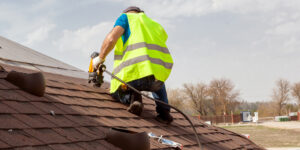
Roofing is an essential component of any structure, providing protection from the elements and maintaining the integrity of a building. Whether you’re a homeowner looking to maintain your property or a business owner in need of commercial roofing solutions, understanding the different roofing services and their processes is crucial. In this comprehensive guide, we will delve into various roofing services, exploring their processes and the importance of each in ensuring a durable and reliable roof. To learn more you can visit Roofing Companies In Columbus Georgia.
Roof Inspection Services
The foundation of any successful roofing project begins with a thorough roof inspection. This service is essential for identifying existing issues, potential problems, and planning for preventative measures. The process typically involves:
- Visual Inspection: A trained roofing professional carefully examines the roof’s surface, looking for signs of damage, wear, or aging. This includes assessing the condition of shingles, tiles, or other roofing materials.
- Interior Inspection: Checking the interior, such as the attic or crawl space, helps identify leaks, insulation problems, and ventilation issues. This step is crucial in understanding the overall health of the roof system.
- Flashing and Gutter Assessment: The inspection extends to critical components like flashing around chimneys, vents, and skylights. The gutter system is also evaluated to ensure proper drainage and prevent water damage.
Roof Repair Services
Once issues are identified through inspection, roof repair services come into play. Roof repairs are necessary to address damages promptly and prevent them from escalating. The process involves:
- Shingle Replacement: Damaged or missing shingles are replaced to restore the roof’s protective layer. This can involve carefully removing the old shingles, inspecting the underlying structure, and installing new shingles.
- Flashing Repair: Damaged flashing around chimneys, vents, or other penetrations is repaired or replaced to prevent water infiltration. Properly functioning flashing is crucial for maintaining a watertight seal.
- Leak Detection and Patching: Locating and patching leaks is a meticulous process. Roofers use various techniques, such as water testing or thermal imaging, to identify the source of leaks and apply appropriate patches or sealants.
Roof Replacement Services
When a roof reaches the end of its lifespan or sustains extensive damage, roof replacement becomes necessary. The process involves a comprehensive overhaul of the existing roof:
- Material Selection: Choosing the right roofing material is crucial for longevity and performance. Options include asphalt shingles, metal roofing, tile, and more, each with its unique advantages and considerations.
- Old Roof Removal: Before installing a new roof, the existing roofing material is removed carefully. This may involve stripping away layers of old shingles, underlayment, and inspecting the underlying structure for any issues.
- Installation of New Roofing Material: The chosen roofing material is installed following manufacturer guidelines and local building codes. Attention to detail during installation ensures a durable and weather-resistant roof.
Roof Maintenance Services
Regular roof maintenance is key to extending the lifespan of your roof and preventing costly repairs. The process includes:
- Cleaning: Removal of debris, leaves, and moss to prevent water pooling and potential damage.
- Gutter Cleaning: Ensuring gutters are free of debris helps maintain proper water drainage and prevents water damage to the roof and foundation.
- Inspection: Regular inspections catch small issues before they become major problems, allowing for timely repairs and prolonging the roof’s life.
Commercial Roofing Services
Commercial properties often have different roofing needs than residential buildings. Commercial roofing services encompass:
- Flat Roofing Solutions: Many commercial buildings have flat roofs, requiring specialized materials and installation techniques. Common options include EPDM, TPO, or modified bitumen.
- Roof Coatings: Applying reflective coatings can enhance energy efficiency, protect against UV damage, and extend the life of the roof.
- Maintenance Programs: Commercial roofs benefit from routine maintenance programs to identify and address issues promptly.
Benefits
- Preventative Maintenance for Longevity: Regular roof inspections and maintenance services offer the benefit of prolonging the lifespan of your roof. By identifying and addressing issues early on, such as damaged shingles, deteriorating flashing, or clogged gutters, you can prevent minor problems from escalating into major repairs or premature roof replacement. Investing in preventative maintenance ensures that your roof remains structurally sound and resilient against harsh weather conditions, ultimately saving you money on costly repairs down the line.
- Enhanced Protection and Safety: Roof repair and replacement services provide the essential benefit of enhancing the protection and safety of your property. A well-maintained and properly functioning roof acts as the first line of defense against rain, wind, snow, and other environmental elements. By promptly addressing leaks, weak spots, or structural damage, you can mitigate the risk of water infiltration, mold growth, and potential structural compromise. Ensuring the integrity of your roof not only safeguards your property but also protects the health and safety of its occupants.
- Improved Energy Efficiency: Certain roofing services, such as roof coatings and materials upgrades, offer the benefit of improving energy efficiency and reducing utility costs. Reflective roof coatings can help deflect sunlight and reduce heat absorption, thereby lowering indoor temperatures and lessening the strain on HVAC systems during hot summer months. Similarly, choosing energy-efficient roofing materials, such as metal or cool roofs, can contribute to lower energy consumption and increased comfort levels inside the building. Investing in energy-efficient roofing solutions not only reduces your environmental footprint but also saves you money on long-term energy expenses.
- Increased Property Value: Whether you’re a homeowner or a commercial property owner, investing in roofing services can significantly increase the value of your property. A well-maintained and visually appealing roof enhances curb appeal, making your property more attractive to potential buyers or tenants. Additionally, a structurally sound roof with a long lifespan can be a significant selling point during real estate transactions, providing peace of mind to prospective owners or tenants. By investing in professional roofing services, you not only protect your investment but also maximize its resale or rental value in the future.
- Peace of Mind and Long-Term Savings: Perhaps the most significant benefit of investing in roofing services is the peace of mind and long-term savings they provide. Knowing that your roof is in good condition and well-maintained gives you confidence in the safety and integrity of your property. By addressing issues proactively and investing in preventative maintenance, you can avoid costly emergency repairs or premature roof replacements, ultimately saving you money in the long run. Additionally, regular roofing services help you stay ahead of potential problems, allowing you to budget and plan for future maintenance and repairs effectively. Overall, investing in professional roofing services offers invaluable peace of mind and financial security for property owners.
Cost Considerations
- Initial Investment vs. Long-Term Savings: When considering roofing services, it’s essential to weigh the initial investment against the long-term savings. While some services, such as routine inspections and maintenance, may incur relatively low upfront costs, they can save you significant expenses by preventing major repairs or premature roof replacement. On the other hand, more extensive services like roof replacement or major repairs may require a higher initial investment but can offer substantial long-term savings by ensuring the durability and longevity of your roof. By carefully evaluating the cost-benefit ratio of different roofing services, you can make informed decisions that align with your budget and long-term goals.
- Factors Influencing Costs: The cost of roofing services can vary depending on several factors, including the size and complexity of the roof, the type of roofing material used, the extent of damage or deterioration, and the location of the property. Additionally, labor costs, overhead expenses, and market demand can impact service pricing. For example, roof replacement on a large commercial building with a complex roof structure may require more materials and labor, resulting in higher costs compared to a simple residential roof repair. It’s essential to obtain multiple quotes from reputable roofing contractors and carefully consider all factors when estimating the cost of roofing services.
- Cost of Preventative Maintenance: Investing in preventative maintenance services, such as roof inspections and regular cleanings, typically incurs lower costs compared to major repairs or replacements. The cost of preventative maintenance can vary depending on the frequency of service, the size of the roof, and any additional tasks required, such as gutter cleaning or sealing. While the upfront cost of preventative maintenance may seem minimal, it can save you substantial expenses by identifying and addressing minor issues before they escalate into costly repairs. Additionally, preventative maintenance helps prolong the lifespan of your roof, reducing the need for premature replacement and saving you money in the long run.
- Cost of Roof Repairs: The cost of roof repairs can vary widely depending on the extent and nature of the damage. Minor repairs, such as patching small leaks or replacing a few damaged shingles, may incur relatively low costs. However, more extensive repairs, such as repairing structural damage or replacing large sections of the roof, can be more expensive. Roof repair costs may also be influenced by the type of roofing material used, accessibility to the damaged area, and the level of expertise required. It’s essential to address roofing issues promptly to prevent further damage and mitigate repair costs.
- Cost of Roof Replacement: Roof replacement is often one of the most significant expenses associated with roofing services. The roof replacement cost depends on factors such as the size and pitch of the roof, the type of roofing material selected, and any additional work required, such as removing the existing roof or repairing underlying structural damage. While roof replacement may involve a substantial upfront investment, it offers long-term benefits in improved durability, energy efficiency, and property value. By choosing high-quality materials and hiring experienced roofing contractors, you can ensure a successful roof replacement project that provides lasting protection for your property.
Understanding the various roofing services and their processes is vital for maintaining a structurally sound and resilient roof. Whether it’s a routine inspection, essential repairs, a complete replacement, or specialized commercial roofing services, each plays a crucial role in ensuring the longevity and performance of your roof. Regular maintenance and timely interventions can save you money in the long run while providing peace of mind that your property is well-protected from the elements. Invest in the health of your roof, and it will continue to shelter you for years to come.








